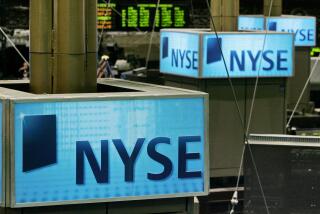Corporate Profits: A Lull, Then a Boom?
- Share via
The stock market’s near-term future may be in the hands of corporate chief financial officers.
Beginning next week, second-quarter earnings reports will begin to roll out, attracting perhaps even more investor scrutiny than usual.
With stocks overall near record highs--and in many cases at or near record valuations, meaning price relative to underlying earnings per share--investors will need to see decent profit increases to justify holding stocks at current prices, let alone to bid them higher.
The good news is that the average year-over-year percentage earnings gain for blue-chip companies is expected to be in the low-double-digit range, despite the economy’s slower pace.
The bad news is that the expected growth would represent a deceleration from the first quarter.
The question is whether investors can look past a second-quarter slowdown and buy into Wall Street analysts’ collective projection that earnings gains will accelerate in the second half of 1997, and into 1998.
What’s more, if their track record stays intact, the analysts’ estimates, as strong as they are, may actually be underestimating how good future growth will be.
*
For now, however, the focus will be on the second-quarter numbers. Here’s what Wall Street expects:
* For the 500 companies in the blue-chip Standard & Poor’s stock index, Wall Street analysts’ estimates for the individual companies they follow add up to an expected 9.1% rise in operating earnings (i.e., earnings before one-time gains or losses) overall, versus the second quarter of 1996, according to First Call, a Boston-based firm that tracks estimates.
* Because analysts generally have been too conservative in estimating earnings over the last three years--on average, their growth estimates have been 2.6 percentage points too low per quarter--First Call’s research chief, Chuck Hill, figures actual S&P; earnings growth will come in at about 12% for the quarter.
* If Hill is right, 12% earnings growth would be “damn good, in absolute terms,” he says, especially considering the major challenges companies faced in the second quarter: weaker U.S. consumer demand after the first-quarter consumption surge, and the dollar’s continuing ascent against many European currencies, making life tougher for U.S. exporters.
Nonetheless, a 12% increase would be a decline from the first quarter’s pace, when S&P; operating earnings grew 15%, according to First Call.
And any earnings deceleration in the current market environment may not be well-received by investors, with stock prices nearing the stratosphere.
*
Hill, however, argues that the S&P;’s first-quarter earnings gain was artificially inflated because the economy in the first quarter of 1996 was hurt by bad weather in the East.
In any case, he adds, a decline from 15% growth to 12% growth wouldn’t be nearly as shocking to Wall Street as the profit growth slowdown of mid-1996.
S&P; earnings rose 10.1% in the second quarter of 1996 from a year earlier. But in the third quarter of last year, earnings were up just 5.5%, coinciding with the economy’s sharp slowdown.
So it wasn’t just a coincidence that the stock market plunged last July: Investors were accurately anticipating weaker corporate profits. The fear was that the profit slowdown would continue into the fall and into 1997.
As it turned out, the slowdown ended quickly. Earnings growth accelerated in the fourth quarter of last year and in the first quarter of this year, with the economy’s pickup. And the stock market responded in kind.
Of course, the S&P;’s overall earnings figure ultimately isn’t important to anyone but a few Wall Street investment strategists and economists. What matters to investors, whether institutional or individual, are the results posted by their particular companies.
*
Could the analysts have it wrong this time--instead of underestimating earnings growth in the second quarter, could they be overestimating for their companies?
In theory, that shouldn’t happen, because many companies’ chief financial officers guide analysts fairly closely on earnings.
Why, then, have analysts underestimated results so significantly in recent years? One theory is that companies routinely guide analysts with overly conservative numbers, even though the companies know they’ll do better.
After all, your stock has the best chance of going higher if you beat Wall Street’s earnings estimates. Coming in below estimates is an invitation to a selling panic.
Meantime, the “how” of these profit numbers--how companies are continuing to perform so well in wringing more earnings from operations, despite wicked global competition--nags many a Wall Street veteran. Profit growth has almost seemed too good to be true.
Yet while there certainly is leeway for chief financial officers of major companies to “manage” earnings gains from quarter to quarter, using all sorts of accounting techniques, earnings overall inevitably track the economy’s trend over time--as recent results have shown.
*
So if we can believe the analysts, second-quarter earnings should be decent, insofar as the economy didn’t fall out of bed. More important, analysts expect earnings to accelerate in the second half of ‘97, to the 14% to 15% annualized growth range--not far below the heady pace of 1993-95.
The big question is this: If those earnings estimates are in fact on target--or even too conservative--doesn’t that suggest the U.S. and global economies will be growing at a brisk pace? And if that’s the case, will that growth be met by higher interest rates here and abroad? Or will inflation stay low enough, despite faster growth, to keep central banks largely at bay?
Global stock markets now appear to be pricing in the latter wondrous scenario. Stay tuned.
(BEGIN TEXT OF INFOBOX / INFOGRAPHIC)
Ready to Resurge?
Second-quarter earnings gains for blue-chip companies are expected to slow, on average, from the first quarter, but will resurge in the second half, continuing the bullish profit trend that began in 1992, according to Wall Street analysts. Annual percentage change in operating earnings (i.e., earnings before one-time gains and losses) for the Standard & Poor’s 500 companies from 1990 to 1995, and quarterly gains since then:
1995: 17.5%
Estimated fourth-quarter ‘97: 14.7%
* Estimate
Sources: Goldman Sachs, First Call
More to Read
Inside the business of entertainment
The Wide Shot brings you news, analysis and insights on everything from streaming wars to production — and what it all means for the future.
You may occasionally receive promotional content from the Los Angeles Times.









